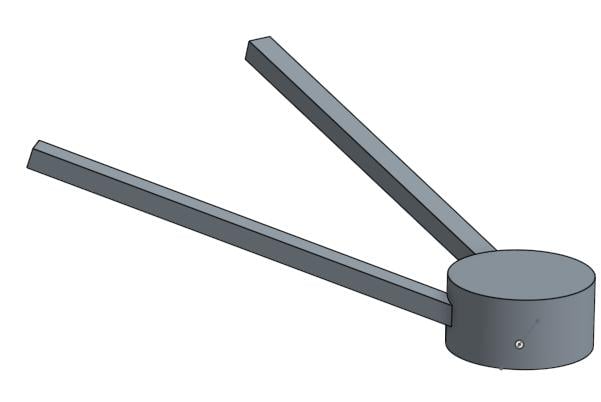Welcome to the Onshape forum! Ask questions and join in the discussions about everything Onshape.
First time visiting? Here are some places to start:- Looking for a certain topic? Check out the categories filter or use Search (upper right).
- Need support? Ask a question to our Community Support category.
- Please submit support tickets for bugs but you can request improvements in the Product Feedback category.
- Be respectful, on topic and if you see a problem, Flag it.
If you would like to contact our Community Manager personally, feel free to send a private message or an email.
What is the proper way to model this?
 øyvind_kaurstad
Member Posts: 234 ✭✭✭
øyvind_kaurstad
Member Posts: 234 ✭✭✭
in General
Look at this very basic model:

It is just a circular base shape, and it has two protruding arms. The arms are pointing upwards, and they are also pointing outwards from each other.
Assume that I want the top surfaces of these arms to be parallell, so that a plane surface would rest flat on both arms.
What is the best way to model something like this? The model shown here isn't correct, it just shows the basic shape I'm after. The easiest method I could find, was actually to create a plane just above the arms, and then use replace face to make the top surface of the arms parallell, but somehow that feels like cheating. I could of course create that plane first, and then sketch on it and extrude down, but that would make the attaching point to the base look slightly funny. I should add that in this example I only modeled one of the arms, and then mirrored it.
This is probably a painfully basic question for you experienced modellers out there, but for a novice it isn't immediately obvious how to best do this.

It is just a circular base shape, and it has two protruding arms. The arms are pointing upwards, and they are also pointing outwards from each other.
Assume that I want the top surfaces of these arms to be parallell, so that a plane surface would rest flat on both arms.
What is the best way to model something like this? The model shown here isn't correct, it just shows the basic shape I'm after. The easiest method I could find, was actually to create a plane just above the arms, and then use replace face to make the top surface of the arms parallell, but somehow that feels like cheating. I could of course create that plane first, and then sketch on it and extrude down, but that would make the attaching point to the base look slightly funny. I should add that in this example I only modeled one of the arms, and then mirrored it.
This is probably a painfully basic question for you experienced modellers out there, but for a novice it isn't immediately obvious how to best do this.
0

Answers
_Dave_
projektowanieproduktow.wordpress.com
https://cad.onshape.com/documents/4d3a3befc86f475c86e135ad/w/ea2bd8a23ebc4bdcbf2079cf/e/ef012749ae6d47fca116b6b6
https://cad.onshape.com/documents/61fd6dfb5b97417f8abeaf8d/w/f16f5e7e0a394ee6810d51eb/e/9a1dddfc791d440d8c6dc853
projektowanieproduktow.wordpress.com
projektowanieproduktow.wordpress.com
However, to acheive this, some geometry has to look weird, so to speak. If the intersection between the circular part and the arms looks good, and the top faces are coplanar, then the end faces of the arms will not be rectangular.